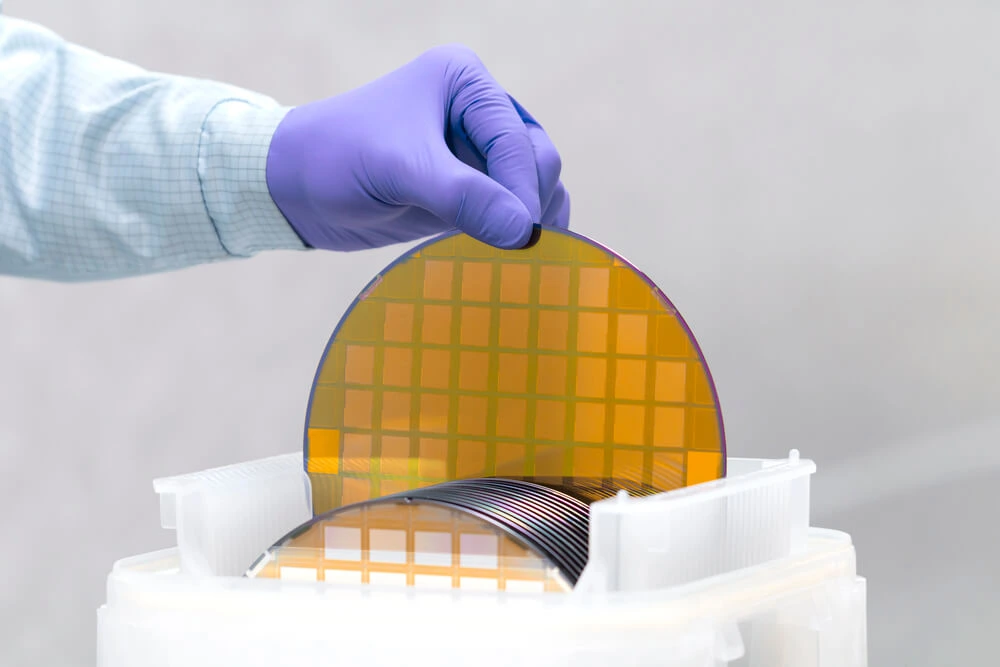When evaluating materials for their projects, engineers and scientists often focus on electrical properties. However, for certain applications, the thermal conductivity of a substrate can help them decide between silicon, GaAs, or InP wafers.
Thermal conductivity is crucial in high-frequency and optoelectronic applications where heat dissipation matters. In that field, indium phosphide stands out among other semiconductor materials.
Thermal conductivity measures the ability of a material to conduct heat. It is temperature-dependent and can be calculated using the formula: k = 0.46 + 0.0002 * (T - 300), where k is the thermal conductivity in W/mK and T is the temperature in Kelvin.
Thermal conductivity is crucial in semiconductor devices as it affects heat dissipation. A higher thermal conductivity allows for better heat removal, preventing device overheating and improving performance and reliability.
The thermal conductivity of InP has a value of approximately 68 W/m·K at room temperature (300 K), which is moderate compared to other semiconductor materials. Therefore, it’s the go-to substrate in applications where heat dissipation plays a big role.
In certain applications, particularly high-power, high-frequency, or optoelectronic devices, heat can build up, degrading performance and reliability.
In these cases, InP (Indium Phosphide) is often selected as the substrate because it balances good electronic properties with better thermal conductivity than alternatives like GaAs. Some of these cases include:
Devices such as MMICs (Monolithic Microwave Integrated Circuits), RF amplifiers, and high-speed transistors (like HEMTs and HBTs) operate at GHz to THz frequencies, generating significant heat.
In these cases, InP wafers are recommended, as their superior thermal conductivity (compared to GaAs, for example) helps prevent thermal runaway and maintain performance. InP maintains high electron mobility and higher breakdown voltage, while offering heat dissipation, keeping good performance while staying reliable.
Lasers, photodetectors, optical transceivers, and modulators for fiber-optic communication are thermally sensitive. Excess heat can shift wavelength, degrade coherence, or reduce efficiency.
InP is lattice-matched to many key III-V materials (like InGaAsP) used in telecom wavelengths (1.3–1.55 µm), resulting in moderate heat conduction to manage thermal loads better than GaAs.
When multiple optoelectronic functions are integrated into one chip, thermal density increases. For that reason, ICs like data centers, coherent optical transceivers, and LiDAR systems require thermal conductivity like that of indium phosphide.
InP enables both active and passive photonic components on one substrate with better thermal handling than silicon photonics (which requires heterogeneous integration of lasers).
This helps prevent overheating of lasers and modulators, reduces wavelength drift in temperature-sensitive components, and maintains performance in high-speed, high-density optical interconnects.
Low thermal conductivity is ideal within thermoelectric materials, but substrates must still dissipate external heat efficiently. This is the case for advanced thermoelectric cooling or energy harvesting systems, which are still under research.
In these cases, InP is sometimes used with low thermal conductivity thermoelectric layers to balance structural and heat flow needs.
Sadly, there’s no perfect material. InP has some limitations, particularly that it’s a highly sensitive material, with thermal conductivity varying with crystal orientation, doping, and temperature.
During device design and fabrication, understanding these changes is essential.
Thermal conductivity (κ) in semiconductors is mainly governed by phonon transport, which is the vibrations of the crystal lattice that carry heat.
As temperature increases, phonon–phonon scattering increases, reducing the mean free path. This lowers κ, especially in non-metallic materials like InP. An example of κ changing based on temperature is:
Thermal management must be dynamic. Devices that work at elevated temperatures need thermal mitigation strategies, such as heatsinks, thermal vias, or better package design. Additionally, design simulations must account for temperature-dependent κ to avoid overheating in operation.
InP has a cubic and anisotropic zincblende crystal structure, which results in slightly different thermal conductivity along different crystal directions.
The reason why this happens is that phonon scattering is affected by atomic spacing and symmetry. Slight anisotropy in phonon dispersion leads to directional differences in κ. While differences are slight (typically <10%), it can matter in precision applications
This means that choosing the right orientation is fundamental during manufacturing. By doing so, manufacturers can balance electrical performance, optical coupling, etch rates, and thermal management.
Doping introduces impurity atoms into the lattice. These atoms disturb the crystal periodicity and cause phonon scattering due to mass difference and strain fields. Overall, they reduce κ, especially at high doping concentrations.
While the effects in lightly doped InP are minimal, heavily doped substrates can experience a 10–30% thermal conductivity decrease, depending on dopant type and concentration.
This can be quite a challenge for manufacturers of power devices or photonics, which require heavy doping in contacts or waveguides, potentially creating hot spots. To balance conductivity and thermal flow, careful thermal modeling and possibly non-uniform doping profiles are a must.
Heat buildup can occur if not localized, affecting nearby structures or degrading device lifetime.
Like any material, indium phosphide properties change when exposed to environmental changes. Manufacturers aim to understand—and adapt—to these changes, utilizing strategies like:

As you can see, indium phosphide is a material that offers numerous benefits, especially for optoelectronic, high-frequency, or high-power devices. While its moderate thermal conductivity is ideal, issues like doping and crystal orientation can impact its performance, leading to uneven heating, reducing the product’s lifespan, or impacting performance.
Luckily, today's manufacturers are aware of these challenges and have developed effective strategies to sort them. The secret lies in understanding your needs and how a specific material contributes to fulfilling them.
If you’d like to learn more about indium phosphide, contact Wafer World for more information!